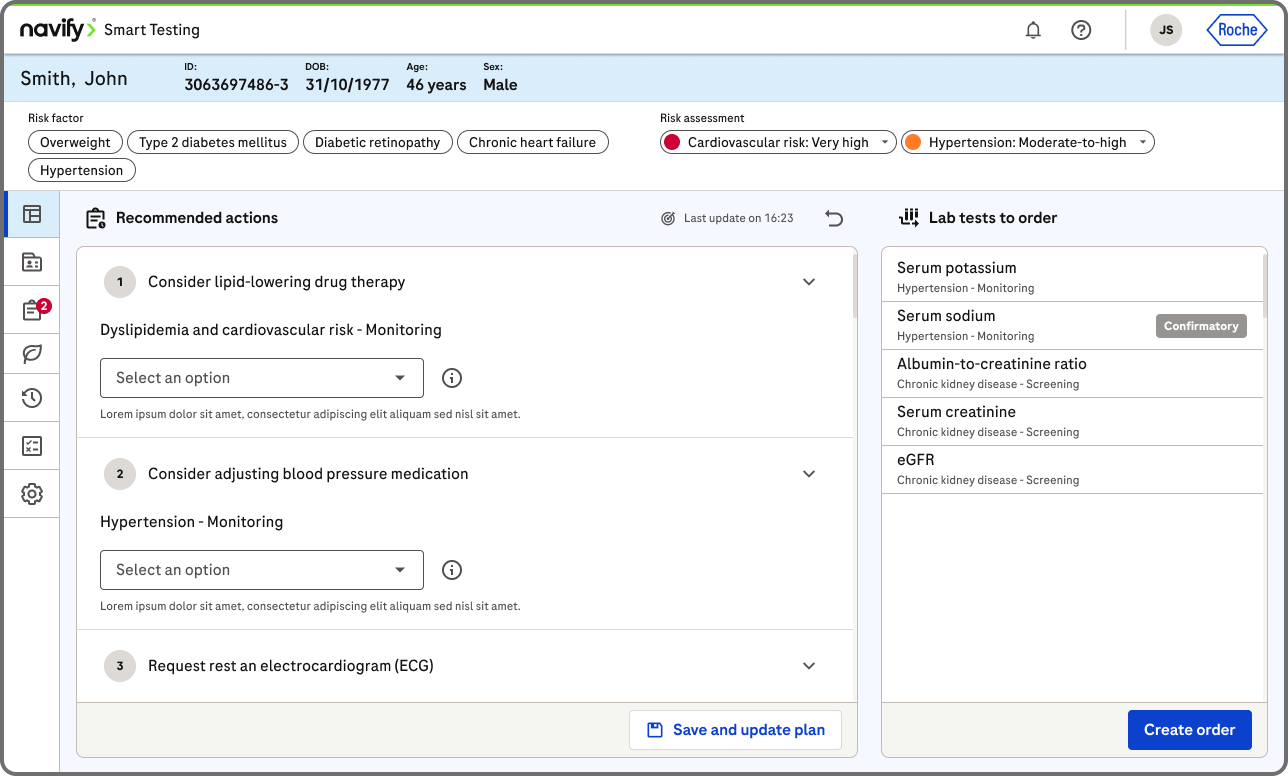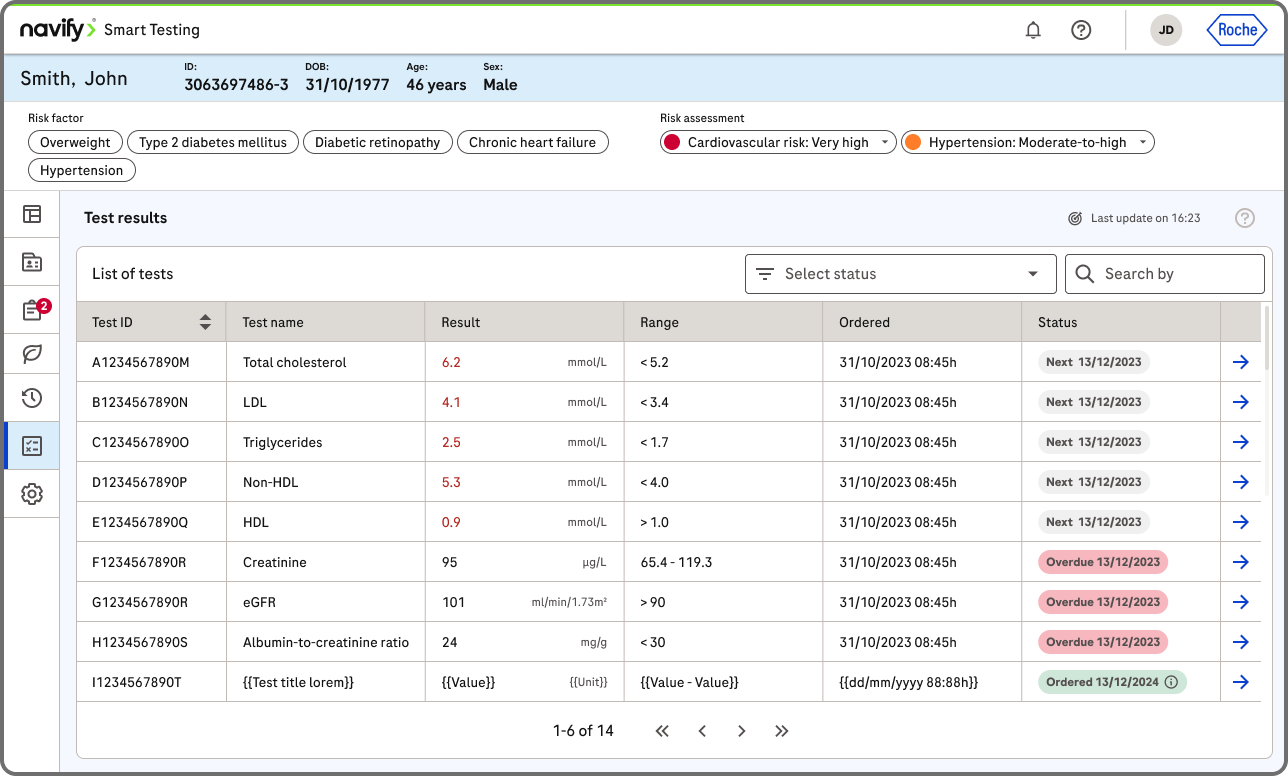Standardizing chronic disease management
In collaboration with Roche Diagnostics, I contributed to the product design of navify Smart Testing, a clinical decision support tool that optimizes diagnostics in primary care. This innovative system assists clinicians in choosing the proper tests at the right time, improving diagnostic accuracy and healthcare efficiency.
My Role
As a Product Designer, I was responsible for:
• Collaborate with managers, engineering, and research to define and design thoughtful solutions.
• Present the design results to stakeholders and then socialize the design deliverables to the development team.
• Participate in UX reviews, usability testing, and iterative improvements.
• Translate complex ideas into user flows, wireframes, and interactive prototypes.
• Facilitate design workshops and contribute to cross-functional decision-making.
• Maintain clear Figma documentation and support smooth handoff to development.
• Ensure consistency through Design System, accessibility standards, and UX guidelines.
As a Product Designer, I was responsible for:
• Collaborate with managers, engineering, and research to define and design thoughtful solutions.
• Present the design results to stakeholders and then socialize the design deliverables to the development team.
• Participate in UX reviews, usability testing, and iterative improvements.
• Translate complex ideas into user flows, wireframes, and interactive prototypes.
• Facilitate design workshops and contribute to cross-functional decision-making.
• Maintain clear Figma documentation and support smooth handoff to development.
• Ensure consistency through Design System, accessibility standards, and UX guidelines.
Summary
Chronic conditions are a leading cause of death, accounting for 74% of all deaths globally (41 million deaths annually). Despite this, many patients are under-screened and receive suboptimal monitoring for chronic diseases and their complications.
navify® Smart Testing is a software application being developed to help primary care physicians (PCPs) access the latest clinical guideline recommendations on prevention, screening and monitoring of chronic diseases. Combining patient risk factors and test results, navify Smart Testing provides physicians with up-to-date screening and monitoring plans.
In a controlled setting involving 18 primary care physicians across France and Switzerland, the tool increased adherence to chronic kidney disease (CKD) screening guidelines by 30%.
Cognitive Support: PCPs reported that navify Smart Testing helped them:
• Remember regular screening and monitoring tests
• Stay up-to-date with clinical guidelines
• Remember regular screening and monitoring tests
• Stay up-to-date with clinical guidelines
Beyond CKD: In 70% of the cases, participants incorporated at least one recommendation related to other chronic diseases, showing the tool's broader effectiveness.
The Challenge
Despite advancements in diagnostics, inappropriate test ordering (both under- and overutilization) remains widespread, leading to delayed or incorrect diagnoses and increased healthcare costs.
“Only 55% of primary care clinicians report having enough
information to make optimal diagnostic decisions.”
— navify White Paper
information to make optimal diagnostic decisions.”
— navify White Paper
Our goal was to design a clinical decision support tool that:
• Integrates seamlessly into existing EMR workflows.
• Supports evidence-based testing recommendations.
• Improves clinicians’ confidence and decision-making speed.
• Enhance the efficiency and accuracy of patient care for general practitioners.
• Integrates seamlessly into existing EMR workflows.
• Supports evidence-based testing recommendations.
• Improves clinicians’ confidence and decision-making speed.
• Enhance the efficiency and accuracy of patient care for general practitioners.
Research iterations & Discovery
To understand the pain points of test ordering, we worked with:
• Clinical simulation environments
• General practitioners and EMR system users
• Data on test ordering inefficiencies and diagnostic errors
• Clinical simulation environments
• General practitioners and EMR system users
• Data on test ordering inefficiencies and diagnostic errors
Key insights:
• Clinicians face cognitive overload in choosing from hundreds of tests.
• Time constraints in primary care limit thoughtful decision-making.
• EMR systems often lack intuitive decision support tools.
• Clinicians face cognitive overload in choosing from hundreds of tests.
• Time constraints in primary care limit thoughtful decision-making.
• EMR systems often lack intuitive decision support tools.
Design Process
1. Research & Discovery
To understand the landscape, I collaborated with business stakeholders to generate user research interviews for clinicians in some countries like Taiwan, Australia, France, Spain, and the USA. Key findings included:
• PCPs prioritize efficiency over manual guideline referencing.
• Usability and seamless integration with existing EMR systems were critical for adoption.
• Notifications and automation could drive better test adherence.
To understand the landscape, I collaborated with business stakeholders to generate user research interviews for clinicians in some countries like Taiwan, Australia, France, Spain, and the USA. Key findings included:
• PCPs prioritize efficiency over manual guideline referencing.
• Usability and seamless integration with existing EMR systems were critical for adoption.
• Notifications and automation could drive better test adherence.
2. UX Strategy & Information Architecture
• Defined user personas (PCPs, Nurses, Lab Technicians, Health Administrators).
• Mapped user journeys to highlight pain points in current workflows.
• Developed a system framework that seamlessly connects to EMR, minimizing cognitive load.
• Defined user personas (PCPs, Nurses, Lab Technicians, Health Administrators).
• Mapped user journeys to highlight pain points in current workflows.
• Developed a system framework that seamlessly connects to EMR, minimizing cognitive load.
3. Prototyping & UI Design
I created a high-fidelity prototype in Figma, ensuring an intuitive, physician-friendly interface for quick decision-making with:
• A dynamic test recommendation module, adapted for patient risk factors.
• An embedded test interpretation & next steps guidance to reduce uncertainty.
• Integration with LIS (Laboratory Information Systems) and EMRs.
Key UI Features:
• Guideline-Based Decision Support – Automated, evidence-driven test suggestions.
• Smart Notifications – Alerts for overdue screenings & abnormal results.
• Dashboard Insights – Aggregated data for tracking patient health and chronic conditions.
I created a high-fidelity prototype in Figma, ensuring an intuitive, physician-friendly interface for quick decision-making with:
• A dynamic test recommendation module, adapted for patient risk factors.
• An embedded test interpretation & next steps guidance to reduce uncertainty.
• Integration with LIS (Laboratory Information Systems) and EMRs.
Key UI Features:
• Guideline-Based Decision Support – Automated, evidence-driven test suggestions.
• Smart Notifications – Alerts for overdue screenings & abnormal results.
• Dashboard Insights – Aggregated data for tracking patient health and chronic conditions.
4. Testing & Iterations
Insights from user feedback led to refinements in:
• Navigation simplifications to reduce clicks.
• More precise visual hierarchy for test urgency.
• Enhanced mobile (tablets) responsiveness for on-the-go access.
Insights from user feedback led to refinements in:
• Navigation simplifications to reduce clicks.
• More precise visual hierarchy for test urgency.
• Enhanced mobile (tablets) responsiveness for on-the-go access.
Impact & Outcomes:
• Adoption & Pilots: Successfully piloted in France and Switzerland with private labs and PCPs.
• Efficiency Gains: Reduced test ordering errors and improved adherence to chronic disease guidelines.
• Economic Value: Increased test volume for labs and quality-based payments for physicians.
• Scalability: Expansion roadmap includes oncology, pediatrics, and infectious disease screenings.
• Adoption & Pilots: Successfully piloted in France and Switzerland with private labs and PCPs.
• Efficiency Gains: Reduced test ordering errors and improved adherence to chronic disease guidelines.
• Economic Value: Increased test volume for labs and quality-based payments for physicians.
• Scalability: Expansion roadmap includes oncology, pediatrics, and infectious disease screenings.
Conclusion
Smart Testing exemplifies human-centered design in healthcare, balancing clinical rigor with usability. As a Product Designer, my focus was on making complex medical decision-making effortless through an intuitive and scalable interface.
Smart Testing exemplifies human-centered design in healthcare, balancing clinical rigor with usability. As a Product Designer, my focus was on making complex medical decision-making effortless through an intuitive and scalable interface.





Complementary information
Medical Screening
Involves the use of tests, exams, or other procedures to identify potential health disorders or diseases in people who do not yet show symptoms. The goal is early detection and intervention.
Medical Monitoring
Refers to the ongoing observation and assessment of a patient's health status, particularly those with chronic conditions or at high risk of developing them. It involves regular follow-up and tracking of health indicators.
Involves the use of tests, exams, or other procedures to identify potential health disorders or diseases in people who do not yet show symptoms. The goal is early detection and intervention.
Medical Monitoring
Refers to the ongoing observation and assessment of a patient's health status, particularly those with chronic conditions or at high risk of developing them. It involves regular follow-up and tracking of health indicators.
Disclaimer: Product in development, piloted in selected markets.